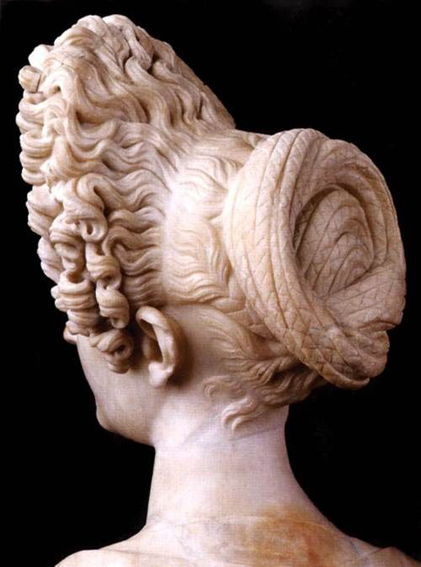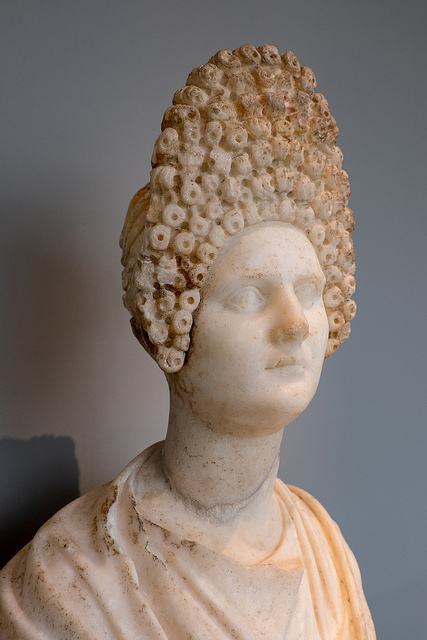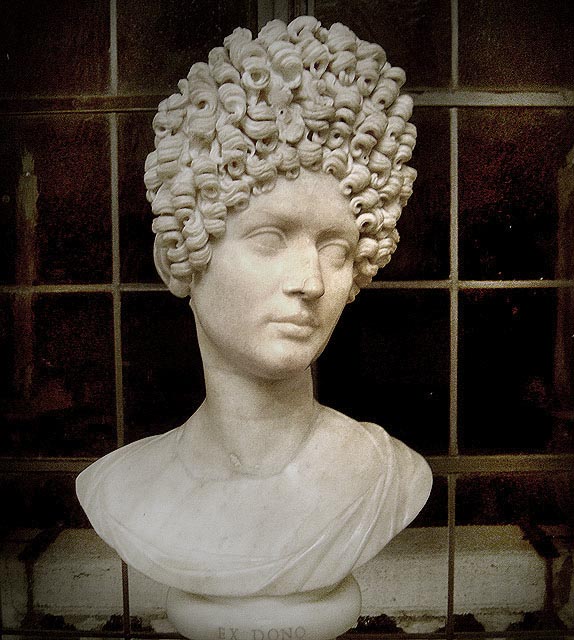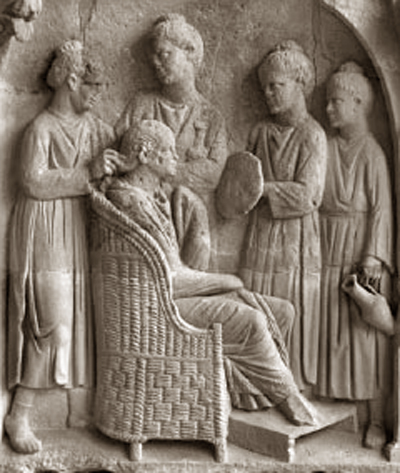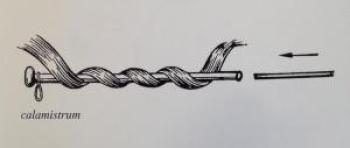In the previous post, we learned that women’s clothing in ancient Rome was not terribly varied: respectable women worn the stolla and palla and differentiated themselves from one another with variations of color and jewelry. Adulteresses and prostitutes were most notably marked by the wearing of the toga, or at times a stolla that was made of thin and revealing Coan silk. A woman’s moral character was indicated by her choice of clothing, and prostitutes were marked by either various degrees of nudity or the willful rejection of “female” dress.[1]
The previous post dealt a blow against the myth that says “the problem in 1 Tim. 2 and 1 Pet. 3 is one of women dressing immorally, as indicated by their prostitute-like hair.” In recognizing that hair didn’t indicate that someone was immoral, the previous post also posited the question: What did “braided hair and gold or pearls” indicate?
This brings us to today’s topic: it’s hair.
THE SIGNIFICANCE OF HAIR
Seeing that Roman culture provided far less variety of choice for women on the front of clothing, women mainly set themselves apart from one another with their hairstyles. In New Testament times (and far before and after), “hair was a major determinant of a woman’s physical attractiveness and was thus deemed worthy of considerable exertions to create a flattering appearance.”[2] In fact, Roman culture was somewhat different than our own in that female hair was the main course of fashion. In Roman culture, clothes were of far lesser significance than hair. Hair “functioned as marker of status” and “seems to have been for some the seat of female attractiveness.”[3] In other words, a woman’s hair was the major factor in determining her physical attractiveness.[4]
In the New Testament era, given that their clothing options didn’t really include anything that was physically flattering, a women’s hair was one of her main outlets of her individuality. Hair communicated a world of details about a woman; social status, personal morality, submission to social norms, and even political leanings.[5] To the Romans, “natural” looking hair was hair “suggesting a lack of civilization and social control – a state close to beasts and barbarians” and grooming was seen as a handmaiden of literacy and culture.[6] Therefore, all Roman women groomed their hair. The nature and level of elaboration of the hairstyle, along with the types of additional elements (i.e. decorations, wigs, etc.) clearly communicated a woman’s status.
Before exploring the various components of Roman women’s hairstyles, it’s worth noting just how much hair communicated.
Hairstyles did change in Roman culture, but slowly and often with far more significance than simply indicating changes in fashion trends. Often the hairstyle of the reigning monarch became a multi-decade standard fashion. Dr. Kelly Olson writes, “some famous Roman women – Livia or Faustina the younger – never (or rarely) changed their hairstyle.”[7] Alexandra Croom writes that “women wishing to be fashionable, wherever they lived in the Empire, could use the official statues and coin portraits to follow the latest hairstyles from the Imperial court if they so wished.”[8] What’s more interesting is that Bartman notes “Faustina the Elder had nine official portraits made over her reign that showed changing hairstyles, where as the coins minted during her reign had the same hairstyles.”[9] Bartman suspects that the coins reveal an idealized image presented by the government to the empire, but seeing that the various hairstyles of the portraits corresponded with other known hairstyles of other important women (both contemporaneous and of the past), the official statues reveal “responses to dynastic politics rather than changes made in the actual coiffure she wore.”[10]
In other words, Faustina provided contemporary political commentary by means of her hairstyle. Croom notes that Imperial women often introduced new fashions “to distinguish herself from her predecessor” but “some women presumably continued to wear the fashions of previous empresses.”[11] The reasons for this certainly involved an aversion to change (tradition is a powerful force), but hairstyles were also subtle ways of showing an affiliation to a previous monarch’s person or political policies.
There were further messages communicated by women’s hair. Roman women wore their hair up on their heads at all times, with two public exceptions. The first exception was for mourning or being part of a funeral procession; adult women letting their hair down was associated with death.[12] The second exception was with children; young girls could let their hair down. Elizabeth Bartman writes,
We also see a marked difference in the hairstyling deemed acceptable for preadolescent girls, such as long hair cascading loosely onto the back, compared to that for sexually mature women – equally long hair but controlled through wrapping, tying, and braiding.[13]
There was also one private exception, which would be one of a sexual nature. Women would “let their hair down” with their husbands; something that was far more erotic than one might initially suspect. Due to the intrinsically erotic nature of hair, it was “a lightening rod for anxieties about female sexuality and public behavior. Hence the ancient sources preserve many references to veiling and other strictures regarding female headware.”[14] The Roman god Venus was often shown wearing her hair cascading down over her shoulders, but this was an image that was overtly pornographic in Roman culture. Bartman writes:
An attribute of Venus, shoulder locks are worn by Roman women to evoke the goddess and the qualities connected with her: beauty, sexuality, and fertility. As divine signifiers they are no different in their associate role from nudity or the gesture of the hand covering the pubis…[15]
So all this gives a simple and obvious message: in ancient Rome, a woman’s hair was not just hair. This also should certainly give Christians a greater understanding of the cultural background behind the talk of veiled hair in 1 Corinthians 11. It’s not an interpretive key by any means, but it certainly adds some understanding of the gravity present in the Corinthian predicament.
Addressing the idea of veiling as a bit of a side-note, it is actually significant to note that a “vast majority” of the surviving portraits (read “statues/busts”) of Roman women have their hair unveiled, most likely “in order to display her elaborate hairstyle to the viewer.”[16] It is likely that those same women would have been unable to wear such elaborate hairstyles out in public without uncovering them, since the palla “would have crushed the rows of curls and braids”.[17] Then again, they probably didn’t wear those sorts of hairstyles too often in public. It’s likely that when sitting for a portrait, a women would have had her hair done up as ostentatiously as possible, in order to present herself as extravagantly as possible and to preserve her astonishing coiffure for posterity.
CREATING THE ‘DO
Not all coiffures were extravagant, but women’s hair was highly significant in Roman culture. Lengthy grooming sessions weren’t just tolerated, they were encouraged for women.[18] There certainly wasn’t a certain hairstyle, but all women wore their hair up and the social scale involve increasing levels of ornate hairstyles.[19] If “natural” hair was the mark of illiterate barbarians, the whole point of Roman women’s hairstyles was to make woman’s hair look as unnatural as possible, with mounds of curls, color, texture and sheen.[20]
So what were the typical hairstyles?
The basic style involved parting the hair in the middle of their head, pulling it back into various styles of braids and buns.[21] Lower class women had simple hairstyles, “usually with the hair drawn back and knotted into a simple bun.”[22] Lower class women would have kept their hair in place with a hairpin, which would have generally been a functional rather than decorative piece. Women of some means would have had more elaborate hair pins that were ornamental and designed to display their wealth.[23]
As in contemporary culture, hairstyles and fashion weren’t driven by the lower classes. The wealthy and elite citizens of the empire established and maintained the standards of fashion, and in the Roman empire the more elaborate the hairstyle, the better.
Roman women who were in the upper classes had exceedingly ornate hairstyles. Hairstyles kept the basic division in the middle of the head but involved increasingly elaborate braids, buns, pins, and decorative elements including ornaments made of gold or ivory, and even various mounds of curls that crowned the forehead, often involving both a woman’s own hair and a wig.[24] This forehead crown was the most distinctive element of Roman women’s hairstyles, often being a stack of curls that was impossibly high.[25] These elaborate hairstyles were held down firmly in place with hairpins, nets and snoods.[26] In the first century, around the time of the pastoral epistles, some women even wore hairnets made out of gold.[27]
Women who wore the most ornate hairstyles would have had their hair done daily by hairdressing slaves called Ornatrices, simply because it would take multiple sets of hands several hours to do the elaborate hairstyles that the wealthy women wanted.[28] Here you can see a wealthy Roman woman with four ornatrices (with one holding a mirror for the woman to observe the affair).
The most elaborate hairstyles, reserved for women with significant means, ”were probably sewn together without the need of hairpins, creating very stable hairstyles that could be slept in if necessary”[29] The richer the women, the larger and more elaborate the mound of hair upon her head. Across the first century, women’s hair was swept “off the face into towering mounds.”[30] Even though Roman women frequently utilized wigs to get maximum effect, many women had “Ample locks, possibly even below waist-level” that were the foundation of their amazing hairstyles.[31]
The point of a wig was to add color to a woman’s hair, but wigs were quite expensive. Women who couldn’t afford a wig could still try to color their own hair, making their hairstyles stand apart from those of their peers. To dye their hair black, women would apply “a mixture of leeches which have rotted for 40 days in red wine” or a mixture of kermes that had soaked in water “until tender and rotten”.[32] To dye their hair red, women would apply “a mixture of very young walnuts” or saffron.[33] To lighten their hair, women would apply sapo, “a mixture of goat’s fat and beechwood ash, molded into balls.”[34] As good as these treatments sound, they weren’t as desirable as having an expensive wig.
The wigs used were wither the half wig (galerus or galerum) or the full wig (capillamentum).[35] Common wigs were frequently made from the hair of slaves, but more expensive wigs had hair of specific and desirable colors. The natural color is what made foreign wigs so desirable (and expensive). Black wigs were imported from India and were very exotic, but blond wigs were brought back from Germany as a spoil of war. This golden “captured hair” was far more exotic and as such was easily the most expensive.[36] Incorporating a foreign and costly wig into a complex and ornate hairstyle would certainly set a woman apart, as “the long commitment of time and the skilled ornatrix needed to produce such a (sp) ornate hairstyle would have marked the woman as a lady of standing, and was a sign of social rank and power.”[37]
Bartman writes that wigs were worn by choice as a fashion accessory, not because of a fault or flaw in the wearers’ hair.[38] I suspect that this is only partially true. Roman women’s hair was also regularly damaged as part of the process of creating a hairstyle. Olson writes about the Roman version of the curling iron and says:
The calamistrum was the ancient curling iron: it consisted of a hollow metal cylinder with a solid cylinder inside: the hair would be wound around the solid cylinder and inserted into the hollow one which had been heated on the fire or in the brazier. Because curling tongs and hair dyes could seriously burn the hair and scalp and cause hair loss, some women may have found thin or scorched hair a problem. [39]
Ouch with bells on!
So, after all that, it seems fairly clear that a woman’s hair in Roman culture was a something of extreme significance, often designed with the sole purpose of displaying a woman’s wealth and status. With the pursuit of elaborate hairstyles possibly involving multiple slaves, imported decorations and wigs, coloring, hours of daily work and what would amount to a lot of money, hair was no small affair for many Roman women. Still, this is just a bunch of data that need to be applied for it to really be helpful.
That’s the goal of the following posts, but first there’s one thing left to deal with before assembling all this data into a coherent understanding of “modesty”. Next, I’ll deal with a remaining elephant in the room.
[1] Kelly Olson, “Matrona and Whore: Clothing and Definition in Roman Antiquity” in Prostitutes and Courtesans in the Ancient World (ed. A. Faraone and Laura K. McClure; Madison, WI: University of Wisconsin Press, 2006), 197.
[2] Elizabeth Bartman, “Hair and the Artifice of Roman Female Adornment.” American Journal of Archaeology Vol. 105, No. 1 (Jan., 2001), 1.
[3] Kelly Olson, Dress and the Roman Woman: Self-Presentation and Society (Park Square, Milton Park, Abingdon, Oxon: Routledge, 2008), 71.
[4] Bartman, 5.
[5] Ibid.
[6] Ibid, 6.
[7] Olson, Dress and the Roman Woman, 71.
[8] Alexandra Croom, Roman Clothing and Fashion (The Hill, Stroud, Gloucestershire: Amberley Publishing, 2010), 65.
[9] Bartman, 8
[10] Ibid, 8.
[11] Croom, 55.
[12] Ibid, 57.
[13] Bartman, 6.
[14] Ibid, 5.
[15] Ibid, 22.
[16] Olson, Matrona and Whore, 190.
[17] Ibid.
[18] Bartman, 1
[19] Croom, 56.
[20] Bartman, 5.
[21] Ibid, 2.
[22] Olson, Dress and the Roman Woman, 71.
[23] Croom, 55.
[24] Bartman, 3.
[25] Olson, Dress and the Roman Woman, 70.
[26] Bartman, 3.
[27] Croom, 66.
[28] Jerome Carcopino, Daily Life in Ancient Rome (trans. E. O. Lorimer; London: Penguin Books, 1991,), 186-187.
[29] Croom, 65.
[30] Bartman, 3.
[31] Olson, Dress and the Roman Woman, 71.
[32] Ibid, 72.
[33] Ibid.
[34] Ibid, 73.
[35] Ibid, 74
[36] Bartman, 14.
[37] Olson, Dress and the Roman Woman, 71.
[38] Bartman, 18.
[39] Olson, Dress and the Roman Woman, 73.






